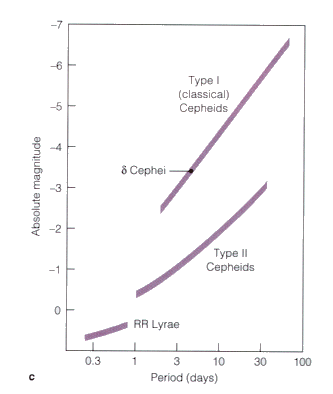Addendum 12: Galaxies: Distance indicators, Hubble's law (Chap 20)
First define some astronomical and physics constants and dimensional units that may be needed below
























1. Distance Determination I: Cepheid (and RR Lyrae) Varables. Cepheid and RR Lyrae variable stars have a definite relationship between luminosity variation period and mean luminosity, as shown in the plot below. Cepheid variables are type F to type K supergiants - yellow in color, pulsating stars, relatively rare, named for the first known star of the group, Delta Cephei (constellation of Cepheus). Pulsating periods that range from 3 to 50 days, and luminosities that are about 1000 to 10,000 times greater than the Sun. Their variations in luminosity range from a few percent to a factor of 10.
They are important because the length of their pulsation period is directly related to their absolute magnitude. By observing the period of variation we can determine a Cepheid's absolute magnitude. Then by comparing the star's absolute magnitude to its apparent magnitude, we can easily calculate the distance of the star. This is the technique that Hubble used in 1927 to determine the distance to the 'great Andromeda' nebula, proving conclusively that it is well outside the MW galaxy.Several hundred cepheid variables are known in our Galaxy. Polaris (the North Star), is a cepheid variable with a period just under 4 days.

Example: The light curve of the star HV 837, a classical Cepheid variable, is shown below. Calculate the distance to this star, assuming no visual extinction along the line of sight.
from plot
mean apparent magnitude
This is the distance to the irregular LMC and SMC galaxies, companions to the Milky Way galaxy.
2. Distance determination II: Type Ia Supernovae. A Type Ia supernova occurs in a binary system in which a mass-losing evolved star dumps mass onto a white dwarf [WD] companion. When the mass of the WD exceeds the Chandrsekhar limit for stable WD's (1.41 Msun), it becomesa supernova. The peak absolute magnitude of the SN is thought to be very nearly the same for all Type Ia SN, viz. Mv = -19.92 +/- 0.13. This is ~13 magnitudes brighter than the brightest Cepheids, so the maximum distance that can be probed using Type Ia SN is much greater. A typical SN light curve is shown below.
Example: Calculate the distance to the spiral galaxy NGC3982, in which Type Ia supernova SN1998aq was discovered (plot above). Assume that in the direction of the SN there is 1 magnitude of visual extinction.
3. Hubble's Law, z<<1. The epochal 1929 discovery that galaxies are moving away in proportion to their distance was Hubble's greatest contribution to astronomy, and perhaps the most important cosmolgical discovery ever. The Hubble law can be written;
where H is the Hubble constant, with a current value is 71 +/- 8 km/s. The velocity V is determined by measuring the resdshift and using the Doppler law. The redshift z is defined as
So that the Hubble law can also be written:
Example: The optical spectrum of a distant galaxy is shown below (note: abscissa is in Angstroms, 1A = 0.1 nm). The most prominent emission line has been identified as the Ha line of hydrogen. What is the distance to this galaxy?
from carefully measuring line wavelength on plot
Lab (rest) wavelength of Ha line of hydrogen From previous lectures, math addenda.
4. Hubble's Law, full relativistic form. If the speed of recession is large (z close to 1 or greater) the simple form of Hubble's lawin section 3 above is not correct. The fully-relativistic form, derivable from the GR theory, is:
Example: The most distant galaxy ever measured (as of mid-2005) has a redshift z = 6.6.
(a) What is its distance [Mpc]?
(b) How long ago did the light from the galaxy start its journey?
13.3 billion yrs ago!